Outlook App on Andro7d Says It Cant Upload Photo Gif to Send
How to ready common epitome-related problems in signatures
Trouble:
You experience various problems with images in email signatures, e.g. embedded pictures are not displayed in received emails, are misplaced in the bulletin thread, or disappear when replying/forwarding.
Solution:
Embedded images are images that are inserted straight into the trunk of the message, as opposed to images that are attached as divide files or inserted as links. CodeTwo software allows yous to embed images in email signatures and in most cases such images are improve than linked images (learn more). Occasionally, embedded images may non appear correctly. For case, if images are suddenly gone from a conversation thread, it unremarkably means the email was either converted to a different format (due east.thou. from HTML to RTF) or processed in a way that removed or misplaced images. This article describes the most mutual issues with signature images and explains how to ready them. The problems are divided into several categories and the most common problems are listed commencement.
Frequent issues
- Images are not displayed or you get security warnings when opening emails with CodeTwo signatures
- Images are visible in the original message just disappear from replies or forwards
- Images are visible in original message but disappear or suffer quality loss with every reply
- Images embedded in email signatures created in Outlook are not visible to recipients
Problems related to e-mail client restrictions
- Images are not displayed (and y'all need to download them) or are sent as attachments
Problems related to undesired format conversion
- Default email format and its conversion in email clients
- E-mail format conversion/enforcement by Exchange Server
- Email format conversion by CodeTwo and other third-party software
- Images in signatures are not correctly displayed, eastward.g. disappear or lose quality, specially in long conversation threads
Issues that occur on Apple devices, mobile devices and web-based postal service clients
- Images are replaced with text filenames on Mac and iOS devices (Apple Mail)
- Images disappear because an email is converted to patently text by an Apple device
- Images in signatures are non displayed
- Trouble related to BMP images in ApplePost (iOS 15 and later)
- Images show up every bit attachments in Outlook for Mac
- The Tap to download button appears instead of an paradigm on iOS devices
- Images evidence up as attachments on iOS devices
- Images in email signatures load very slowly in Outlook on mobile devices
- Image formatting or size changes when you lot use Microsoft Outlook for Android
- Embedded images disappear when using spider web-based e-mail clients
Problems related to the image itself
- Unsupported image format or incorrect filename
- Unexpected errors acquired by base64 images
- Incorrect image scaling
- Contour pictures and other images are displayed incorrectly in night style
Other issues
- Outlook is not embedding images
- A signature that contains an epitome simply is not displayed by an email client
Frequent problems
Problem: Images are not displayed or you get security warnings when opening emails with CodeTwo signatures.
Solution: Did you lot insert the image from a web location into your signature? Storing pictures online is a good fashion of reducing email size, but it comes with several disadvantages. If your recipients have express Internet admission or no Net connexion at all, their email clients volition not be able to download images from the external spider web locations. Furthermore, many electronic mail clients (including webmails) come with security features that prevent against automatic downloading of external content linked in emails. If your signature contains images stored in a web location, e-mail recipients may see security warnings. Similar behavior occurs if your electronic mail includes embedded images which are also hyperlinked.
In many cases, embedding images into email signatures can be a better solution. Larn why
Problem: Images are visible in the original message but disappear from replies or frontwards.
Solution: This issue is most probably acquired by email client settings. An email client may be configured to always reply using a specific message format, regardless of the original format. If such format conversion occurs, information technology can cause bug with disappearing images, images visible every bit attachments, CID placeholders or picture names showing up in the message torso instead of images. Similar conversion may happen on the intermediary mail servers every bit well. To mitigate this trouble, you can tell your users virtually information technology and ask them to change their mail client settings, if possible. If you're working in an Substitution environment, you tin can force the HTML email format in Exchange. Another workarounds may be available, for case some iOS versions remove images when replying only keep images when forwarding emails, so forwarding instead of replying may be an choice to keep images in identify.
Learn more well-nigh issues related to postal service format conversion
Trouble: Images are visible in the original message only disappear or endure quality loss with every answer.
Solution: This problem might exist related to unwanted electronic mail conversion past email clients, especially in long chat threads. Go to this section for details.
Problem: Images embedded in email signatures created in Outlook are non visible to recipients.
Solution: If yous experience problems with native Outlook signatures, come across this section.
Problems related to email client restrictions
Images are non displayed (and you demand to download them) or are sent as attachments
This may be caused by email client security restrictions and/or bandwidth usage protection. If an email contains a linked image, your email client might bear witness a blood-red x in a box ( ) icon (Fig. 1.) or an empty movie frame instead or evidence no linked content at all.
) icon (Fig. 1.) or an empty movie frame instead or evidence no linked content at all.
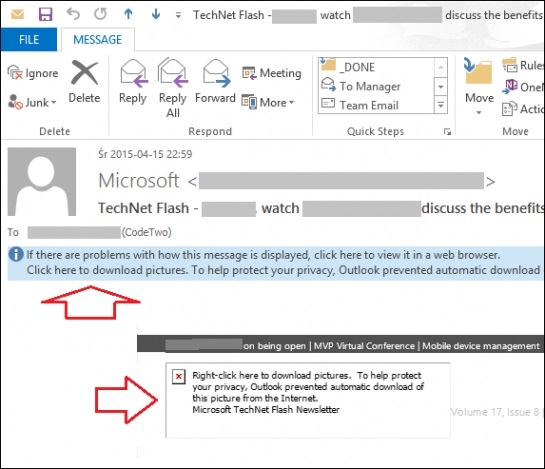
Fig. i. External content is blocked by Outlook.
To solve this issue, you tin use one or more than of the solutions provided below:
- If security restrictions are used, you tin can change the e-mail client settings to enable downloading remote content from the Internet. This can be done directly in the affected message or you can configure how images are handled in all emails using your email client'due south settings. Below are links to instructions on how to do this in some email clients:
- MS Outlook - Block or unblock automatic picture downloads in email messages
- Yahoo - Embedded images are not displayed in emails
- Gmail - Turn images on or off in Gmail
Info
Almost electronic mail clients exercise not automatically download images from external servers considering information gathered while opening remote resource (such as websites) may exist used by their owners to identify visitors.
Even so, owners of remote servers containing the images are only able to obtain your IP address and information on the mail service client yous used to download the images. There is no option to gather whatever credentials used for hallmark on the mail servers.
- If bandwidth restrictions are in identify, you can modify the electronic mail signature and the graphics used in it by:
- limiting the number of images in the signature,
- reducing the size of graphic elements in the signature by using lower-resolution images,
- using different image file types, especially those that let for lossy compression that reduces the file size e.g. JPG (JPEG), instead of files with lossless compression due east.g. PNG or BMP.
- To avoid bandwidth restrictions, you tin can configure your CodeTwo e-mail signature solution to merely add a signature to the kickoff bulletin in a chat past selecting the Add together the [signature] to the first email only (exercise not add it to subsequent emails) option or to remove your previous signatures from a conversation when a new bulletin is sent by selecting the Add the [signature] to every email but remove its previous occurrences in an email chat selection.
Follow the links below to notice out where you can observe these options when using:
- CodeTwo Email Signatures for Office 365
- CodeTwo Exchange Rules family of products
Problems related to undesired format conversion
Default email format and its conversion in email clients
Every mail customer can utilize a different default message composing format. Depending on the platform, y'all can send your bulletin in HTML, RTF or Plain Text. Usually, when you add any formatting or images to a bulletin, your post client automatically switches to the HTML or RTF format. Of course, almost email clients (including Microsoft Outlook, Thunderbird, and Apple Mail service) have an option to manually choose which format should be used.
Tip
If you utilize Apple devices, the default e-mail format conversion might crusade images in your signatures to disappear. Check this department to acquire more.
Currently, we only support HTML signatures with images. Some devices (like iPhones and iPads) are, by default, sending messages in Plain Text, therefore you lot might demand to convert them into the HTML format. You can find more information about this conversion in the sections below.
Info
Go along in mind that the OWA app for iOS and Android supports only signatures in Plain Text.
Email format conversion/enforcement by Commutation Server
The default settings in Microsoft Exchange Server allow postal service clients to transport messages in both the HTML and Plain Text formats. Nevertheless, emails might be delivered in a different format than original because, for example, third-party MS Exchange Transport agents or antivirus software is fix to convert them. MS Exchange Server settings in your environment might too forcefulness electronic mail format conversion to Plain Text - in such a case, CodeTwo software volition add together the Plain Text version of a signature, with no images (other images included in a message volition likewise disappear). See this Cognition Base article to learn how to bank check and modify your default Substitution Server settings to avoid unwanted conversion from HTML to Plain Text.
Tip
If you demand to force email format conversion to HTML, you can utilize CodeTwo software. Meet this section to learn more.
What is more, Commutation Server and email clients are using specific Content-Transfer-Encoding setting to process the messages. Some of the clients may meet bug when downloading images and merging them straight with a bulletin. For case, in Thunderbird y'all may experience a situation when images are located on the list of attachments, instead of inside the trunk of an email. If you have like issues, nosotros advise you to wait for another email awarding.
Email format conversion by CodeTwo and other 3rd-party software
Simply the HTML format is supported by CodeTwo software when it comes to stamping emails with signatures containing images. That is why sometimes y'all might need to convert the message torso to HTML. Fortunately, some of the CodeTwo products tin can automatically do that:
- If you use CodeTwo Exchange Rules Pro, you can convert your emails to HTML by using the functionality called Forcefulness email format. At this point we are not aware of whatsoever possibility to properly convert messages to HTML directly on Microsoft Commutation Server (you can find more information about the Exchange-side behavior before in this article).
- If yous use CodeTwo Email Signatures for Part 365, you can force conversion of apparently text emails to HTML on the Design tab of the signature direction app. Learn more
Some third-party applications may cause unwanted conversion to the Plainly Text format. We strongly recommend verifying your current 3rd-party Exchange tools, add-ins for mail service clients and configuration of your security solutions (including SPAM filters and antivirus software).
Images in signatures are non correctly displayed, due east.g. disappear or lose quality, particularly in long chat threads
In a particularly long message thread, it may happen that images embedded in signatures are non displayed correctly in before messages in this thread (an image appears correctly but in the latest signature, equally shown in Fig. 2.). These images tin be completely removed, modified, or their quality significantly reduced.
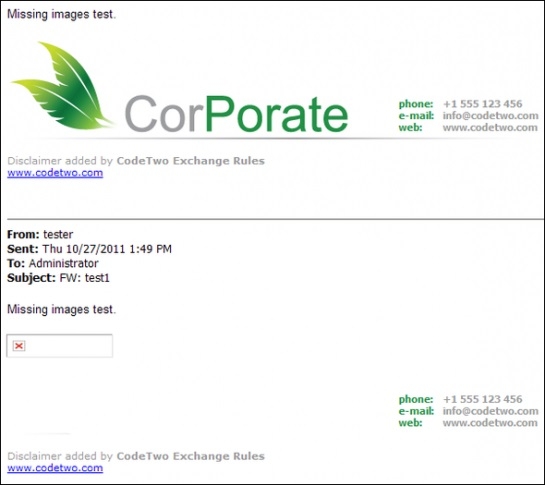
Fig. 2. A signature prototype has been removed from the previous message in a conversation.
This problem is often caused by unwanted electronic mail conversion and is very likely to occur in especially long conversation threads, where a message passes through multiple servers and is viewed on many email clients. In such cases, embedded images can exist completely removed, compressed, modified, or their quality significantly reduced. Too, every fourth dimension the user clicks the Answer or Frontward push button, their email client modifies the entire message thread – it adds a reply header, prepares a place for the reply text, etc. Since there are many email clients on the marketplace (including smartphones and other mobile devices), each with its own rules for processing long message threads and embedded images, there is no universal solution to this issue.
Issues that occur on Apple devices, mobile devices and web-based mail clients
Images are replaced with text filenames on Mac and iOS devices (Apple tree Mail)
When you compose a reply message using Apple Postal service on your Mac or your mobile device, the mail client removes all attachments and replaces them with text filenames surrounded by bending brackets due east.thou.<logo.jpg>, <doc.pdf>, <image001.jpg>past default. This is done to all types of attachments, including standard or inline attachments, to reduce the size of the email you are sending. This behavior also affects images embedded in email signatures as they are, in fact, inline attachments.
While zip can be done to foreclose this from happening at the recipients' side (when the recipients are replying to your messages), consider using one of the following policies to foreclose users in your organization from sending broken letters:
- Tell your users to employ another app similar Outlook, Outlook for iOS or some other app. This is the best arroyo since the beliefs described is sectional to the Apple Post application. Using another app like Microsoft Outlook for Mac / Microsoft Outlook for iOS is the easiest way of solving this issue. Additionally, Microsoft Outlook apps are designed to piece of work in Office 365 and Exchange organizations giving you lot a meliorate experience both in mobile and desktop applications.
- Supervene upon local (embedded) images with web-based images. As the issue is limited to attachments merely, you can employ remote images in your signature. They are not considered attachments but rather references to your images located on a spider web server. Notwithstanding, be advised that since your images are no longer included in your messages, the recipients might exist prompted to download them.
- Configure the Apple Mail app to end removing attachments. If the in a higher place options are non viable in your organization, the terminal resort is to change Apple tree Mail's beliefs to either stop removing attachments (they will be re-added) or inquire the user what to do with them.
Warning
If you configure Apple Mail service to stop removing attachments, this will utilize not merely to embedded images just to all attachments. For an instance, if you receive a PDF file so click/tap reply, Apple tree Mail is going to attach that PDF file once more with your reply message.
Note that this option might significantly increment the size of emails, peculiarly in longer bulletin threads.
To manage how the email customer handles attachments:
- If you utilize a Mac, open the Mail service app, click Edit > Attachments from the drop-down menu and select Include Original Attachments in Respond, as shown in Fig. three. From now on, your Mac will no longer endeavour to delete any attachments or images when you lot are replying to a message.
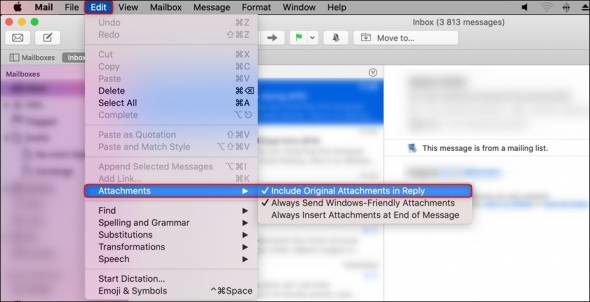
Fig. iii. Preventing Apple Postal service from removing images in email replies on MacOS x.xiv Mojave.
- If you use an iPhone or an iPad with iOS 13 or newer, these settings are found in Full general >Mail >Include Attachments with Replies (Fig. four.). You can set the attachments to be included: always, never, when adding new recipients or to ask you each time.
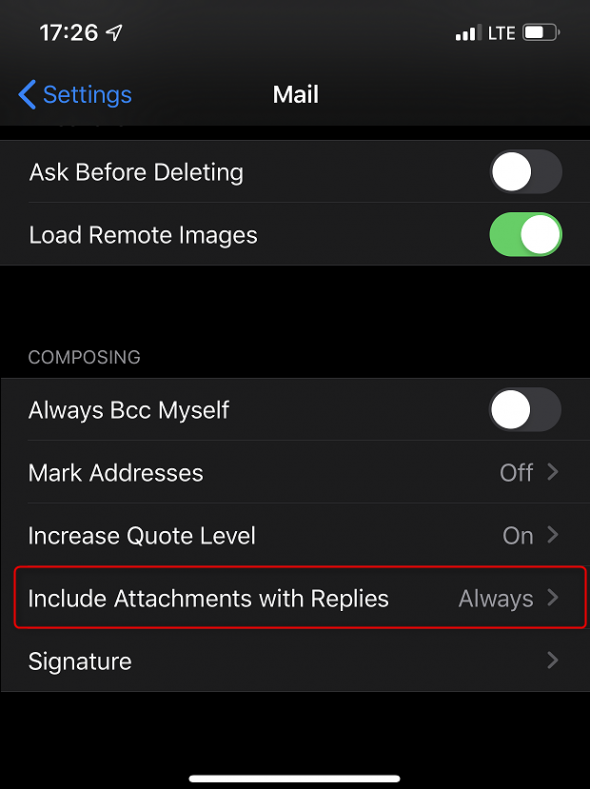
Fig. 4. Preventing Apple tree Mail service app from removing images on iOS 13.
Images disappear because an e-mail is converted to obviously text by an Apple device
Emails sent from Apple devices such as iPhone, iPad and Mac are sometimes converted into the plain text format past the default Post application. For example, if you compose a new message or reply to / forward an existing one and your message does not incorporate any text formatting, it is sent in manifestly text regardless of the electronic mail client settings and the original message format. Images tin can only appear in HTML signatures, that is why they disappear from plain text emails. Encounter this Knowledge Base article to find out how to fix this problem.
Images in signatures are not displayed
Some Apple e-mail clients are not able to display images that are inserted as the only element inside an HTML tag. Meet this section to acquire more about this problem.
Problem related to BMP images in Apple Mail service (iOS 15 and afterward)
Note that this problem applies to all emails that include *.bmp images, regardless whether they are processed by CodeTwo software or not.
If your signature contains at least one image in the BMP format and your recipient uses Apple tree Mailon iOS 15 or after to respond to your email, your signature in the reply may be stripped of all images (regardless of their format). That's considering the default Apple's mobile email client incorrectly changes the <img> tags of the images into the <html> ones in the HTML code of your signature (if there's a BMP image).
At that place's no trouble if your signature includes non-BMP images only (e.g. PNG or JPG) or your recipient uses another email client on their iPhone. That's why the all-time method to avoid the problem is to not add BMP images to your email signatures, disclaimers or auto-replies.
Images show upwardly as attachments in Outlook for Mac
In Outlook for Mac, the embedded images might show upwards as attachments in the terminal message. In fact, Outlook clients designed to piece of work on the Windows platform are changing the filenames of embedded images on each respond and frontwards. Nonetheless, this beliefs does not utilise to Outlook clients on Macs. Consequently, when CodeTwo software adds an image with the same filename as already existing inside a message, Outlook for Mac displays a list of all embedded images in the attachments field. Such a state of affairs might take identify e.g. when a signature including an image is added multiple times into the aforementioned message.
The Tap to download button appears instead of an paradigm on iOS devices
We have also found another problem that occurs in iOS seven and later. Sometimes, the default post awarding displays certain embedded images incorrectly - they are not downloaded to emails, but instead yous see the Tap to download button. When you click it, nothing happens. The problem appears just for messages that were replied to or forwarded via the default mail app (Mail). If you lot are facing such an issue, you can solve it past forcefulness closing the app on your device and reopening information technology.
Images testify up as attachments on iOS devices
If you utilize an iPhone or iPad to respond to or frontwards an email, images embedded in a signature are sometimes removed from the electronic mail body and moved to attachments.
This issue is caused by the email client on your device and is not related to CodeTwo. Some clients, usually the ones on mobile devices, recognize the path to embedded images in the message body and remove these images, putting them in attachments instead. This behavior helps portable devices reduce mobile information usage (the recipient can choose to download images or not).
Images in email signatures load very slowly in Outlook on mobile devices
You employ Microsoft Outlook for iOS/Android. When you open an electronic mail on your mobile device and this email contains a signature with embedded graphics, the embedded images load very slowly.
This trouble relates to the mobile Outlook applications only and is not related to CodeTwo software. To fix it, attempt doing the post-obit:
- force close the app and open it again,
- reset the account cache in your mobile Outlook app. See guidelines below,
- or reinstall the Outlook app on your device.
If none of these solutions works for you, effort contacting Microsoft Support and asking them to troubleshoot your consequence.
Resetting the account enshroud in Outlook for iOS and Android
To reset the account cache (remove cached files) on your mobile Outlook app, you need to:
- Open Microsoft Outlook on your iOS or Android device.
- Get to Settings and tap the account that causes problems with prototype loading.
- Tap the Reset Account button and await for the process to finish.
Paradigm formatting or size changes when yous use Microsoft Outlook for Android
You use Outlook for Android to manage mail on your mobile device. When you reply to or frontwards an email that contains a signature with embedded images, this e-mail falls apart and images are misplaced, resized, etc. Such an event occurs if you lot use the Load Full Message option when responding to messages. Run into this article to learn more than.
Embedded images disappear when using spider web-based email clients
Some of the web-based mail applications do not correctly process messages while replying or forwarding. The e-mail source lawmaking can be modified, therefore the address (i.e. content identifier / CID) of an paradigm embedded into an email may be incorrectly defined. Equally a consequence, images are not visible.
To solve this issue, please first try using a desktop mail client instead of a web awarding. If you are unable to obtain or run such software, please effort changing the format of the images, as described here and check if the trouble persists.
Problems related to the prototype itself
Unsupported image format or incorrect filename
When embedding images to emails and signatures, information technology's best to utilize the most common image formats such every bit PNG or JPG (JPEG), as they are supported past the majority of post clients. If your embedded pictures are not displaying correctly, check their file format and, if necessary, try converting them to i of the mentioned formats.
Incorrect file names might also prevent graphics from beingness displayed in emails. We recommend that you just use letters and numbers. Do not utilise special characters or hashtags (east.m. #myphoto).
Some other trouble may occur if you give generic names to your picture files. By default, Outlook changes the names of images embedded in emails into [email protected], [email protected] and and so on. If you use a simple image name such as image001.png and the proper name of your image matches the proper name generated past Outlook, the images might be swapped and displayed incorrectly (Fig. five.). This problem has been addressed in all current versions of CodeTwo Substitution Rules and Exchange Rules Pro - these programs add together a unique ID to every image inserted (embedded) into a signature. If you use this software to add email signatures, make sure you that you have the latest version installed.
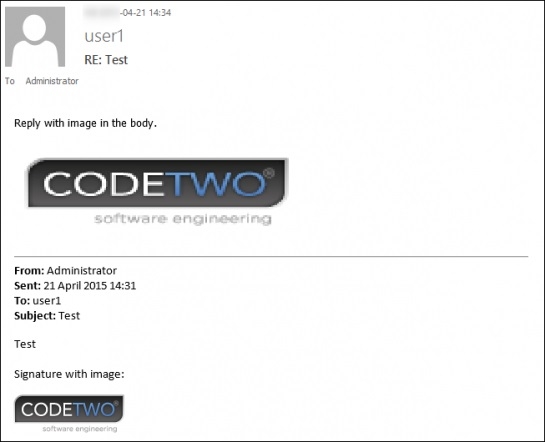
Fig. 5. Misplaced images in Outlook.
Unexpected errors acquired past base64 images
With base64 encoding, you tin can use various information types (images included) directly in your lawmaking (east.g. the HTML lawmaking of your signature) with no need to link to external resources. Unfortunately, most often the encoded data turns out to be greater in size that the original, and a number of base64-encoded images can apace balloon the code and size of your signature. Consequently, you may experience unexpected problems, e.g. failure to insert your client-side signature in Outlook. Larn more than
To summarize, nosotros do not recommend using base64 images in signatures. Instead, you tin can hands embed traditional PNG or JPEG (JPG) image files in your template by using the editor available with CodeTwo Email Signatures for Part 365 or CodeTwo Exchange Rules (Pro). That way, y'all tin can avoid base64-related problems and, at the same fourth dimension, brand the images always visible to your recipients (with no need to click 'download pictures').
Incorrect image scaling
In some environments, especially those with a college DPI setting, you lot may experience bug related to the scaling of images in emails. This effect can be solved by forcing fixed dimensions of the image file. Read this article to learn how to continue the right size of images in your signatures regardless of the mail client/platform.
Contour pictures and other images are displayed incorrectly in dark manner
When a message is opened in an electronic mail client that uses dark mode, the user photo imported into the signature from (Azure) Agile Directory by using the {photo} placeholder does non match the dark background in the e-mail customer. The reason for that is because images in AD are e'er stored in the JPG file format, even if you originally uploaded a PNG image. The JPG format does not support transparency. As a outcome, the original groundwork of the image will always be visible and will non change depending on the light/dark mode settings of the email client.
However, you can still add PNG images with a transparent background to your signature template by using the Picture option. These images will adapt to the background used in dark fashion. Make likewise certain to refer to these guidelines when designing nighttime mode friendly electronic mail signature templates.
Other problems
Outlook is not embedding images
In Outlook 2013 and subsequently, embedding images into emails (including electronic mail signatures created in Outlook) is sometimes not possible. Outlook does non add them to a message, just inserts references to the paradigm files on the local disk of the email sender. As references to local files just piece of work on the sender'southward auto, emails and email signatures are displayed without graphics on the recipients' mail service clients.
This behavior occurs past default in certain Outlook versions. Read this Cognition Base of operations article to learn how to solve this outcome.
A signature that contains an image simply is not displayed by an email client
If your signature template inserts an image but and this image is placed inside an HTML tag such as <p>, <td> or <div>, and so some email clients (such every bit Apple Post) may not display this prototype. If you experience this problem, you can work it around by adding any text next to the image (inside the aforementioned HTML tag). Y'all tin can hide this text so that information technology'south not visible. For example, if your image is inserted in the <td> tag:
<TD><IMG src="your-paradigm.jpg"></TD>
And then you can add a flow (total cease) punctuation mark directly after the image and alter the punctuation marking's colour to white and then that it'due south not visible in your email signature. To do then, the above HTML code can exist changed in the following way:
<TD><IMG src="your-paradigm.jpg"><SPAN style="color: #fff;">.</Bridge></TD>
Come across also:
Bug with emails and email signatures when using mobile devices
| Related products: | CodeTwo Email Signatures for Email Clients, CodeTwo Electronic mail Signatures for Office 365 one.x, CodeTwo Exchange Rules 2.x, 3.ten, CodeTwo Commutation Rules 2007 1.x, 2.x, 3.x, 4.x, CodeTwo Exchange Rules 2010 one.x, ii.x, 3.x, CodeTwo Exchange Rules 2013 1.10, two.x, CodeTwo Exchange Rules 2016 i.x, CodeTwo Exchange Rules 2019 1.x, CodeTwo Exchange Rules Pro 1.ten, 2.x |
| Categories: | FAQ, How-To, Troubleshooting |
| Terminal modified: | 2022-03-01 |
| Created: | 2015-02-25 |
| ID: | 467 |
Source: https://www.codetwo.com/kb/common-image-related-problems-in-signatures/
0 Response to "Outlook App on Andro7d Says It Cant Upload Photo Gif to Send"
Enregistrer un commentaire